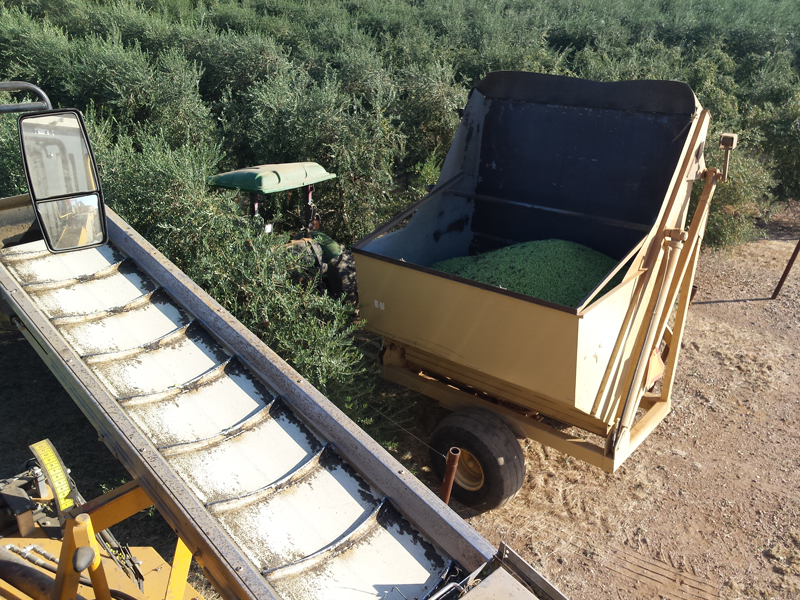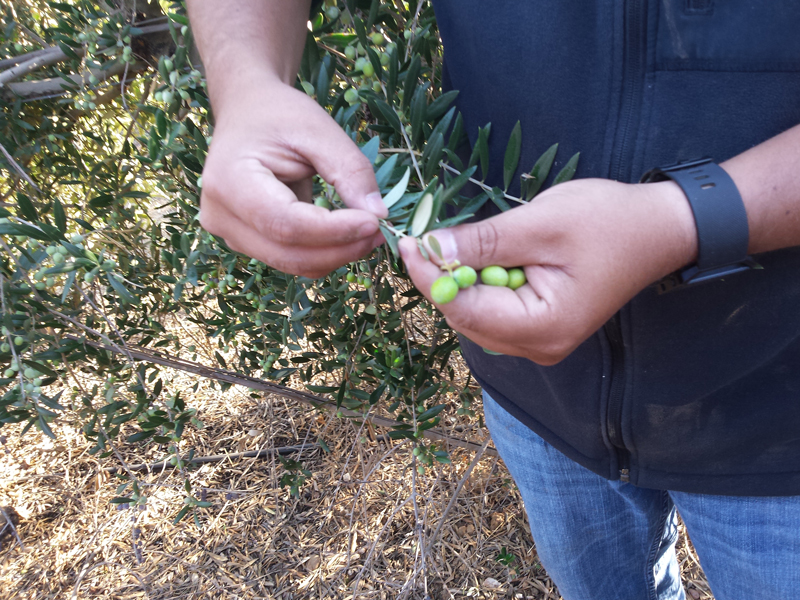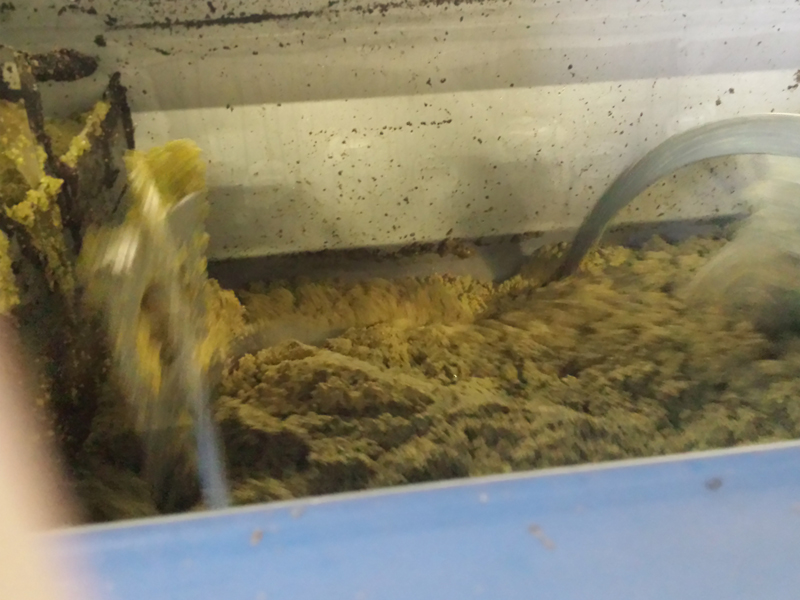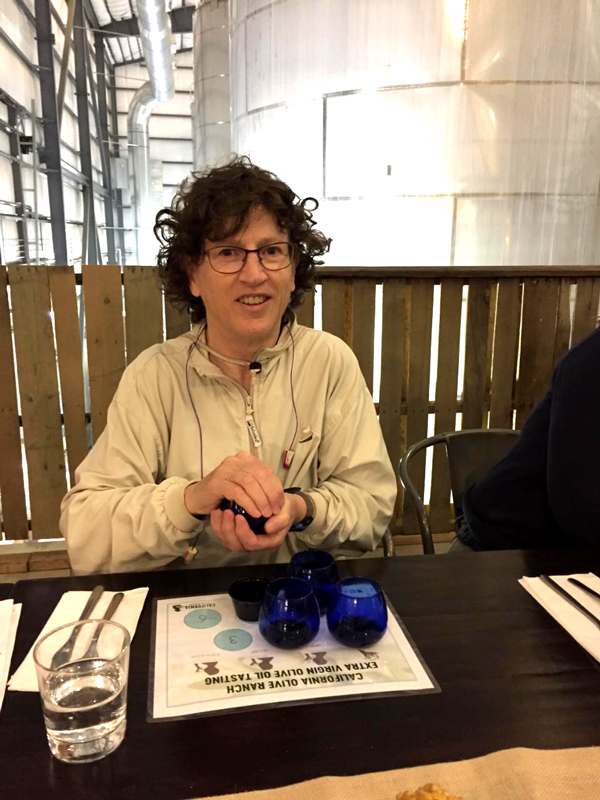BY AUDREY SHEFFIELD
Grocery Purchasing Coordinator
North of Sacramento, beyond endless groves of oranges and almonds, peaches and walnuts, lie thousands of acres of olive trees making up California Olive Ranch. It’s harvest time here. Men and machines are working day and night to collect Arbequina, Arbosana, and Koroneiki olives ripened to a golden glow before the frost comes in late November or December. A handful of buyers from other co-ops and I have come to observe the harvest and milling here at the Ranch. 
We’re met in the fields by Allesandro, who has worked these olive orchards for 20 years. The Ranch currently has about 15,000 acres of olives, with about 560 trees per acre, each tree planted by hand. The crop is mostly Arbequina olives, which are hardy, able to survive rain and frost. Allesandro explains that olives are a fruit and must be pollinated by the wind. Arbosana and Koroneiki olives, spicier than Arbequina, are the pollinators, making up about 30 percent of the trees. The trees are planted in dense rows running north to south, which allows each tree to get the maximum amount of sunlight every day. During the dormant season, trees are mechanically trimmed to a uniform size and shape to further maximize exposure to sunlight, and to make harvesting easy for the mechanical harvesters.
We drive out to the fields where there are large mechanical harvesters and storage bins hauled by tractors. Each harvester has an opening just larger than an olive tree with arms extending into the opening, like the mouth of a baleen whale. The arms gently shake the tree, dropping the olives into collection pans on the harvester. Conveyors transfer the olives to the hopper next to us. It’s a successful year — the bin is full before reaching the end of the row. Harvesting stops while the tractor driver hauls his bin to larger trucks waiting at the side of the field. We climb down from the harvester to walk among the trees.
 Allesandro explains that olives only produce fruit every other year, using the dormant year to expend energy into growing the plant and leaves. A light year might produce only four tons per acre, the olives yielding 40–42 gallons of oil per ton. A heavy year, like this one, can yield 60–70 gallons per ton. The growing season begins in April and May when the trees flower. Northern California’s mild climate is perfect for growing olives. Temperatures between 70° and 85°F are ideal for fruit growth, along with low rainfall and moderate humidity. The trees are irrigated using drip irrigation to minimize evaporation in this semi-arid climate. To force the olives into maturity, irrigation is withdrawn, the olives ripen, and the harvest begins. Allesandro shows us ripe olives, plump and green with a golden glow, full of oil. Some of the trees have purplish fruit, the result of stress from not enough water, or “raisined” fruit, which has passed maturity. Fortunately, these are few and far between. Aerial surveillance gives the olive growers a scientific basis for determining the best time to begin the harvest in late October and early November.
Allesandro explains that olives only produce fruit every other year, using the dormant year to expend energy into growing the plant and leaves. A light year might produce only four tons per acre, the olives yielding 40–42 gallons of oil per ton. A heavy year, like this one, can yield 60–70 gallons per ton. The growing season begins in April and May when the trees flower. Northern California’s mild climate is perfect for growing olives. Temperatures between 70° and 85°F are ideal for fruit growth, along with low rainfall and moderate humidity. The trees are irrigated using drip irrigation to minimize evaporation in this semi-arid climate. To force the olives into maturity, irrigation is withdrawn, the olives ripen, and the harvest begins. Allesandro shows us ripe olives, plump and green with a golden glow, full of oil. Some of the trees have purplish fruit, the result of stress from not enough water, or “raisined” fruit, which has passed maturity. Fortunately, these are few and far between. Aerial surveillance gives the olive growers a scientific basis for determining the best time to begin the harvest in late October and early November.
Once the harvest begins, it’s a race against time to get all the olives off the trees, into the trucks, to the processing mill, and processed into oil. Temperatures over 85°F can bring a harvest to a standstill, so operations are carried out in the evening hours, through the night, and into the cool morning hours. Rain can also bring a harvest to a halt. We’re lucky today, with temperatures in the mid-60s and no rain in sight. Four to six hours after these olives are harvested, they’ll have been crushed, the oil extracted and mellowing in huge storage tanks.
We walk back to our SUVs and take a 15-minute drive from the fields to the processing mill where we’re met by the Plant Manager, Jim. Here, he explains, each double truck full of olives is weighed and tagged so that every olive can be tracked from field to bottle. Random samples are also taken at the weigh station where computers assess the color of the fruit and the oil content, which helps build a consistent flavor profile for the oil. From the weigh station, loads are taken to a dump station where they’re off-loaded into underground bins then conveyed into the mill. Along the way, workers pull sticks and debris from the olives.
 Inside the mill, olives are further sorted from leaves and fruit too small to extract oil, washed, and moved to giant crushers. We walk into the room with the crushers and extractors and are met with a grassy, fresh scent that is the freshly extracted olive oil. To extract the oil, the cell walls in the olives have to be broken by crushing the olives. Once crushed, the olives move to a malaxer where a pulp is created and kneaded. This pulp moves into giant horizontal centrifuges, running at 3,500 RPM, to separate the solid matter from the oil and water. The remaining solids are sold to farmers to use for animal feed. From that point, the liquids move to vertical centrifuges that separate the oil from the water. Here taste testers try the oil for the first time, making sure it meets quality standards to be called extra virgin and to determine the taste profile. The extracted water is reused for crop irrigation and composting.
Inside the mill, olives are further sorted from leaves and fruit too small to extract oil, washed, and moved to giant crushers. We walk into the room with the crushers and extractors and are met with a grassy, fresh scent that is the freshly extracted olive oil. To extract the oil, the cell walls in the olives have to be broken by crushing the olives. Once crushed, the olives move to a malaxer where a pulp is created and kneaded. This pulp moves into giant horizontal centrifuges, running at 3,500 RPM, to separate the solid matter from the oil and water. The remaining solids are sold to farmers to use for animal feed. From that point, the liquids move to vertical centrifuges that separate the oil from the water. Here taste testers try the oil for the first time, making sure it meets quality standards to be called extra virgin and to determine the taste profile. The extracted water is reused for crop irrigation and composting.
At this point, the oil is subjected to chemical analysis by both the Ranch experts and third parties to assess its quality and flavor consistency. Testers want each batch of oil to have the same flavor profile across the entire harvest. The oil is then filtered into holding tanks and tested again. Once approved, the oil is moved into larger, 150,000-gallon tanks that are two or three stories high. This process, called racking, allows any remaining solids to sink to the bottom of the tank and lets the oil “rest,” mellowing some of the bitterness and pungency of the oil. The oil will rest here until December, when it will be pulled out and bottled next door.
 From the racking room, Jim takes us upstairs to the lunch room for a taste testing with Mari, one of the expert tasters at the California Olive Ranch. She explains that the tulip-shaped cups in front of us hold four of the oils produced here. We warm each cup up by holding it in the palms of our hands and swirling it. Then, like wine tasters, we smell the oil, taking in the fruity, grassy scent. To taste the samples, she encourages us to slurp the oil, aerating it between our teeth and tongue. We sip the warm oil, tasting the buttery and grassy flavors before swallowing. The pungency of the oil creates a burning sensation on the back of our throats. Between each oil, we chew a piece of apple to cleanse our palates. We’re trying oils in order of pungency and robustness today: the mild, everyday blend of Arbequina and Arbosana found in the square green bottle, and good for cooking and baking; the Miller’s Blend, a more robust blend of Arbequina and Greek Koroneiki olives; a Lucini-brand everyday blend made of olives from Argentina and Chile; and lastly, oil from today’s harvest, which is peppery, pungent and robust. Mari tells us that in a day, she may drink a half to a cup of olive oil as she tests various batches in the plant.
From the racking room, Jim takes us upstairs to the lunch room for a taste testing with Mari, one of the expert tasters at the California Olive Ranch. She explains that the tulip-shaped cups in front of us hold four of the oils produced here. We warm each cup up by holding it in the palms of our hands and swirling it. Then, like wine tasters, we smell the oil, taking in the fruity, grassy scent. To taste the samples, she encourages us to slurp the oil, aerating it between our teeth and tongue. We sip the warm oil, tasting the buttery and grassy flavors before swallowing. The pungency of the oil creates a burning sensation on the back of our throats. Between each oil, we chew a piece of apple to cleanse our palates. We’re trying oils in order of pungency and robustness today: the mild, everyday blend of Arbequina and Arbosana found in the square green bottle, and good for cooking and baking; the Miller’s Blend, a more robust blend of Arbequina and Greek Koroneiki olives; a Lucini-brand everyday blend made of olives from Argentina and Chile; and lastly, oil from today’s harvest, which is peppery, pungent and robust. Mari tells us that in a day, she may drink a half to a cup of olive oil as she tests various batches in the plant.
We leave with a greater understanding and appreciation for all that goes into getting oil from the field to the shelves in our stores. We are thankful for the passionate dedication of these olive growers who use high-density farming methods, mechanized harvesting and modern processing to create a wonderful extra-virgin olive oil at an affordable price, available every day right here in our stores.
If you want to learn more about the Ranch and their olive oils, please visit their website at californiaoliveranch.com